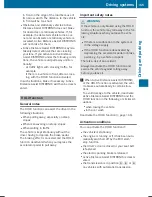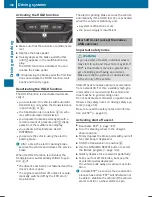
G
WARNING
Flammable material such as leaves, grass or
twigs may ignite if they come into contact
with hot parts of the exhaust system. There
is a risk of fire.
When driving on an unpaved road or off-
road, check the vehicle underside regularly.
In particular, remove trapped plant parts or
other flammable material. Contact a quali-
fied specialist workshop immediately if dam-
age is detected.
!
There is a risk of damage to the vehicle if:
R
the vehicle becomes stuck, e.g. on a high
curb or an unpaved road
R
you drive too fast over an obstacle, e.g. a
curb, a speed bump or a pothole in the
road
R
a heavy object strikes the underbody or
parts of the chassis
In situations like this, the body, the under-
body, chassis parts, wheels or tires could be
damaged without the damage being visible.
Components damaged in this way can unex-
pectedly fail or, in the case of an accident,
no longer withstand the loads they are
designed to.
If the underbody paneling is damaged, com-
bustible materials such as leaves, grass or
twigs can gather between the underbody
and the underbody paneling. If these materi-
als come in contact with hot parts of the
exhaust system, they can catch fire.
In such situations, have the vehicle checked
and repaired immediately at a qualified spe-
cialist workshop. If on continuing your jour-
ney you notice that driving safety is
impaired, pull over and stop the vehicle
immediately, paying attention to road and
traffic conditions. In such cases, consult a
qualified specialist workshop.
The vehicle is only designed for easily negotia-
ble off-road terrain and poor road surfaces.
When driving off-road, substances such as
sand, mud and water or water mixed with oil
may get into the brakes. This could result in a
reduced braking effect or in total brake failure
and also in increased wear and tear. The brak-
ing characteristics change depending on the
material entering the brakes. Clean the brakes
after driving off-road. If you detect a reduced
braking effect or grinding noises, have the
brake system checked in a qualified specialist
workshop as soon as possible. Adapt your
driving style to the different braking character-
istics.
Driving off-road increases the likelihood of
damage to the vehicle, which, in turn, can lead
to failure of the mechanical assembly or sys-
tems. Adapt your driving style to suit the ter-
rain conditions. Drive carefully. Have damage
to the vehicle rectified immediately at a quali-
fied specialist workshop.
Do not shift into transmission position
i
when driving off-road. You could lose control
of the vehicle if you attempt to brake the vehi-
cle using the service brake. If the gradient is
too steep for your vehicle, drive back down in
reverse gear.
General notes
H
Environmental note
Protection of the environment is of primary
importance. Treat nature with respect.
Observe all prohibiting signs.
Read this section carefully before driving your
vehicle off-road.
Off-road driving is only possible with the
ON&OFFROAD package.
The following driving systems are specially
adapted for driving over easily negotiable off-
road terrain:
R
Off-road program (
Y
page 170)
R
Off-road ABS (
Y
page 60)
R
Off-road 4ETS (
Y
page 64)
R
Off-road ESP
®
(
Y
page 66)
R
DSR (Downhill Speed Regulation)
(
Y
page 169)
Observe the following notes:
R
Stop the vehicle before starting to drive
along an off-road route. If necessary, acti-
vate the off-road program (
Y
page 132).
R
To avoid damaging the vehicle, make sure
there is always sufficient ground clearance.
R
Check that items of luggage and loads are
stowed safely and are well secured
(
Y
page 255).
R
Always keep the engine running and in gear
when driving on a downhill gradient. Acti-
vate DSR (
Y
page 169).
154
Driving tips
Drivi
ng
and
parking
















































